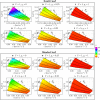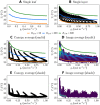Practical Considerations and Limitations of Using Leaf and Canopy Temperature Measurements as a Stomatal Conductance Proxy: Sensitivity across Environmental Conditions, Scale, and Sample Size
- PMID: 38629085
- PMCID: PMC11018642
- DOI: 10.34133/plantphenomics.0169
Practical Considerations and Limitations of Using Leaf and Canopy Temperature Measurements as a Stomatal Conductance Proxy: Sensitivity across Environmental Conditions, Scale, and Sample Size
Abstract
Stomatal conductance (gs) is a crucial component of plant physiology, as it links plant productivity and water loss through transpiration. Estimating gs indirectly through leaf temperature (Tl) measurement is common for reducing the high labor cost associated with direct gs measurement. However, the relationship between observed Tl and gs can be notably affected by local environmental conditions, canopy structure, measurement scale, sample size, and gs itself. To better understand and quantify the variation in the relationship between Tl measurements to gs, this study analyzed the sensitivity of Tl to gs using a high-resolution three-dimensional model that resolves interactions between microclimate and canopy structure. The model was used to simulate the sensitivity of Tl to gs across different environmental conditions, aggregation scales (point measurement, infrared thermometer, and thermographic image), and sample sizes. Results showed that leaf-level sensitivity of Tl to gs was highest under conditions of high net radiation flux, high vapor pressure deficit, and low boundary layer conductance. The study findings also highlighted the trade-off between measurement scale and sample size to maximize sensitivity. Smaller scale measurements (e.g., thermocouple) provided maximal sensitivity because they allow for exclusion of shaded leaves and the ground, which have low sensitivity. However, large sample sizes (up to 50 to 75) may be needed to differentiate genotypes. Larger-scale measurements (e.g., thermal camera) reduced sample size requirements but include low-sensitivity elements in the measurement. This work provides a means of estimating leaf-level sensitivity and offers quantitative guidance for balancing scale and sample size issues.
Copyright © 2024 Ismael K. Mayanja et al.
Conflict of interest statement
Competing interests: The authors declare that they have no competing interests.
Figures









References
-
- Brodribb TJ, Holbrook MA, Zwieniecki NM, Palma B.. Leaf hydraulic capacity in ferns, conifers and angiosperms: Impacts on photosynthetic maxima. New Phytol. 2005;165(3):839–846. - PubMed
-
- Buckley TN. How do stomata respond to water status? New Phytol. 2019;224(1):21–36. - PubMed
-
- Sinclair TR, Tanner CB, Bennett JM. Water-use efficiency in crop production. Bioscience. 1984;34(1):36–40.
-
- Messina CD, Sinclair TR, Hammer GL, Curan D, Thompson J, Oler Z, Gho C, Cooper M. Limited-transpiration trait may increase maize drought tolerance in the us corn belt. Agron. J. 2015;107(6):1978–1986.

